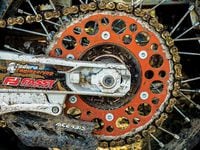Rear chainwheels are traditionally comprised of aluminum; although light, the softer material wears relatively quickly and, through continued use, causes chain stretch and ensuing drivetrain deterioration. Steel chainwheels can last three times longer but carry the penalty of adding three times the unsprung weight and rotating mass.
The Renthal Twinring rear chainwheel utilizes the inherent benefits of both aluminum and steel. An inner CNC-machined 7075-T6 aluminum carrier is mated to a CNC-machined nickel-plated steel outer ring. The outer ring is heated to 392 degrees Fahrenheit, forcing expansion, and placed on the inner ring. Cooling and contraction permanently bonds it to the carrier, with lateral security provided by flat socket set screws. Inner rings are anodized in all OEM bike colors; outer rings are available from 47 to 53 teeth and have mud-clearing grooves machined between each tooth.
I have been testing two Renthal Twinrings, one on a 450 "light adventure" dual-sport bike and one on a two-stroke woods bike. Both chainwheels have endured the extremes of mud bogs and bottomless sand, one with 30 hours and the other with 50 hours. The former shows no discernible wear and the latter shows a slight loss of tooth profile. I have not noticed any movement between the inner and outer rings, and nothing is discoloring or rusting. The Renthal Twinring does cost more than its all-aluminum counterpart, but this is money well spent, as the entire drivetrain will last longer.

/cloudfront-us-east-1.images.arcpublishing.com/octane/WOYUZXUAMBCZZJ3BQWOEQJGR5M.jpg)
/cloudfront-us-east-1.images.arcpublishing.com/octane/OBHVYZHWBBAZTALZA4GC5RM5WA.jpg)
/cloudfront-us-east-1.images.arcpublishing.com/octane/ZJPPRO5CRNFYPEVMWIFR7RRFQQ.jpg)
/cloudfront-us-east-1.images.arcpublishing.com/octane/MMAOLEHZG5CBXAOICNKNGCEK4I.jpg)
/cloudfront-us-east-1.images.arcpublishing.com/octane/KQUVDTNB6VF53CRDNN47BE3VUA.jpg)
/cloudfront-us-east-1.images.arcpublishing.com/octane/3T32INAZQRGPXOGGA36NQJDSSM.jpg)
/cloudfront-us-east-1.images.arcpublishing.com/octane/EPLS5PBKXBHNXK7S5O7G4ND3YQ.jpg)
/cloudfront-us-east-1.images.arcpublishing.com/octane/MNGOZAGZFZBH5DPFV7NOPF5S3Y.jpg)
/cloudfront-us-east-1.images.arcpublishing.com/octane/VGJWIIFM2VBCXG34KRQ37GCP7U.jpg)
/cloudfront-us-east-1.images.arcpublishing.com/octane/2ZU3HXRPMZESJF7HDLZJV7FHEY.jpg)
/cloudfront-us-east-1.images.arcpublishing.com/octane/VVFWQBZEIZDVJHZIW5ISKWKOZU.jpg)
/cloudfront-us-east-1.images.arcpublishing.com/octane/7T7FZXHIIBDX7AOBD5S3IICUJI.jpg)
/cloudfront-us-east-1.images.arcpublishing.com/octane/T3Y7A52TXBEBJNEPGOQSVPQSPU.jpg)
/cloudfront-us-east-1.images.arcpublishing.com/octane/KY33U3WBTNFIBJFMTEF2SM7BOQ.jpg)
/cloudfront-us-east-1.images.arcpublishing.com/octane/JNPS5MGVXJC7BARVMARYQIQHXE.jpg)
/cloudfront-us-east-1.images.arcpublishing.com/octane/63N2P6SYAZDURJDO5KARQYX2J4.jpg)
/cloudfront-us-east-1.images.arcpublishing.com/octane/C72WX35SXFETTO5OVA2RWT523I.jpg)
/cloudfront-us-east-1.images.arcpublishing.com/octane/F3ER37EV2RGY5CRYFNTWE3JSF4.jpg)
/cloudfront-us-east-1.images.arcpublishing.com/octane/L65QCUR32RH2NKCUHXYHHAPDFI.jpg)
/cloudfront-us-east-1.images.arcpublishing.com/octane/VSK246VVRRDMBNQU7B2NTNY6AE.jpg)
/cloudfront-us-east-1.images.arcpublishing.com/octane/CG64RRFAYRENNAP2AA22T2LSJY.jpg)
/cloudfront-us-east-1.images.arcpublishing.com/octane/IKZSRLBWMRDORMORBXSISL4D6M.jpg)
/cloudfront-us-east-1.images.arcpublishing.com/octane/BJLVRPJSDFC3ZLPMW3LYYHMPZE.jpg)
/cloudfront-us-east-1.images.arcpublishing.com/octane/RQW2RFU4MJDYRPVFJNW362SEXU.jpg)